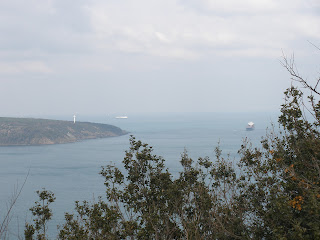Yesterday was sunny after a rainy week, so I hopped on the 15A bus to Anadolu Kavagi, the last ferry stop on the Asian side of Istanbul before the Black Sea. The village is not large and tucked in between forested hills belonging to the Turkish military. A sign in English at the ferry landing notes that the word "kavagi" is derived from the Turkish word "kavak", which means to hold, to stop, to turn around. For the past several centuries, this and Rumeli Kavagi, on the European side of the Bosphorus, mark the point where traffic flow into the Bosphorus can be controled. My own Turkish-English dictionary notes that "kavak" means poplar tree, so I continue to wonder about Turkish signs in English.
Rumeli Kavagi on the opposite bank of the Bosphorus is also a small village known for good fish dinners. Both villages are popular day trip destinations for Istanbulites.
I hiked inland from the village, which also means up hill, to the remains of the Yoros Castle. From this vantage point, great views can be had, ...
looking south towards the Bosphorus, and...
north towards the Black Sea.
The castle was built in the Byzantine style of alternating layers of brick and stone,
and includes marble plaques in Greek, which may identify the name of the family. During the 14th century, the castle was claimed by Byzantines, Ottomans and Genoese at different times. As with all real estate, the strategic key was location, location, and location. 

On the hilltop, there were some free range chickens roaming around as well as bashful guinea fowl (?). They did not let me get too close.
Walking back down the hill, I spotted the most artistic home in the village with their front wall done in broken ceramic pieces, ala Gaudi.
Another enjoyable adventure in Istanbul!








No comments:
Post a Comment